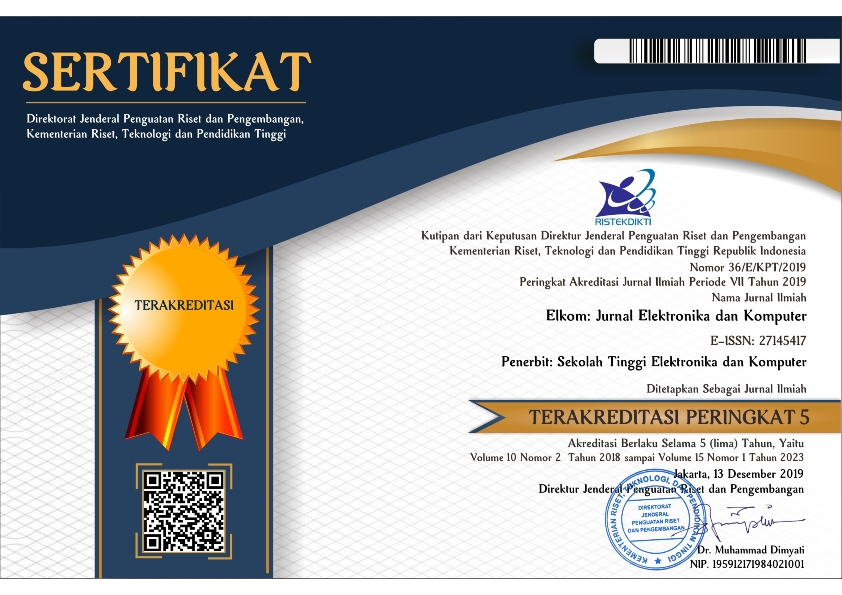Penggunaan Metode K-Means Untuk Menentukan Clustering Kelompok Belajar Siswa
Abstract
Science and technology will facilitate human work. However, on the other hand it will increase competition. In facing intense competition, it is necessary to have competent human resources. Students are expected to be academically prepared, in the form of knowledge and skill readiness to face increasingly fierce competition. One way to see student competence is to look at learning outcomes that can be represented by the exam scores taken. The midterm exam (UTS) is a form of exam which is an assessment component. By knowing the UTS scores, the lecturer knows the distribution of students in terms of academic competence. For this reason, it is necessary to group (clustering) using the k-means algorithm as a consideration for lecturers in forming student study groups based on UTS value clusters.References
[2] A. Elvanisi, S. Hidayat, and E. N. Fadillah, “Analisis Keterampilan Proses Sains Siswa Sekolah Menengah Atas Skills Analysis of Science Process of High School Students.,” J. Inov. Pendidik. IPA, vol. 4, no. 20, pp. 245–252, 2018.
[3] M. K. Nasution, “Penggunaan metode pembelajaran dalam peningkatan hasil belajar siswa,” Stud. Didakt. J. Ilm. Bid. Pendidik., vol. 11, no. 1, pp. 9–16, 2017.
[4] N. M. Dwijayani, “Development of circle learning media to improve student learning outcomes,” J. Phys. Conf. Ser., vol. 1321, no. 2, pp. 171–187, 2019, doi: 10.1088/1742-6596/1321/2/022099.
[5] T. Syahputra, J. Halim, and E. P. Sintho, “Penerapan Data Mining Dalam Menentukan Pilihan Jurusan Bidang Studi SMA Menggunakan Metode,” Penerapan Data Min. dalam Menentukan Pilihan Jur. di Bid. Stud. SMA menggunakan Metod. Clust. Dengan Tek. Single Link. JURTEKSI, vol. IV, no. 2, pp. 1–4, 2018.
[6] Yuda Irawan, “Implementation Of Data Mining For Determining Majors Using K-Means Algorithm In Students Of SMA Negeri 1 Pangkalan Kerinci,” J. Appl. Eng. Technol. Sci., vol. 1, no. 1, pp. 17–29, 2019, doi: 10.37385/jaets.v1i1.18.
[7] P. A. Jusia, F. M. Irfan, and K. Kurniabudi, “Clustering Data Untuk Rekomendasi Penentuan Jurusan Perguruan Tinggi Menggunakan Metode K-Means,” J. IKRA-ITH Inform., vol. 3, no. 3, pp. 75–84, 2019.
[8] I. P. Putra and Zulhijra, “REFORMASI PENDIDIKAN ISLAM DI INDONESIA,” J. PAI Raden Patah, vol. 1 no. 2, p. 117, 2019.
[9] M. R. Firdaus, A. Latif, and W. Gata, “Klasifikasi Kelayakan Calon Pendonor Darah Menggunakan Neura L Network,” Sistemasi, vol. 9, no. 2, p. 362, 2020, doi: 10.32520/stmsi.v9i2.840.
[10] I. Kamila, U. Khairunnisa, and M. Mustakim, “Perbandingan Algoritma K-Means dan K-Medoids untuk Pengelompokan Data Transaksi Bongkar Muat di Provinsi Riau,” J. Ilm. Rekayasa dan Manaj. Sist. Inf., vol. 5, no. 1, p. 119, 2019, doi: 10.24014/rmsi.v5i1.7381.
[11] M. Nishom, “Perbandingan Akurasi Euclidean Distance, Minkowski Distance, dan Manhattan Distance pada Algoritma K-Means Clustering berbasis Chi-Square,” J. Inform. J. Pengemb. IT, vol. 4, no. 1, pp. 20–24, 2019, doi: 10.30591/jpit.v4i1.1253.
[12] R. K. Dinata, S. Safwandi, N. Hasdyna, and N. Azizah, “Analisis K-Means Clustering pada Data Sepeda Motor,” INFORMAL Informatics J., vol. 5, no. 1, p. 10, 2020, doi: 10.19184/isj.v5i1.17071.














